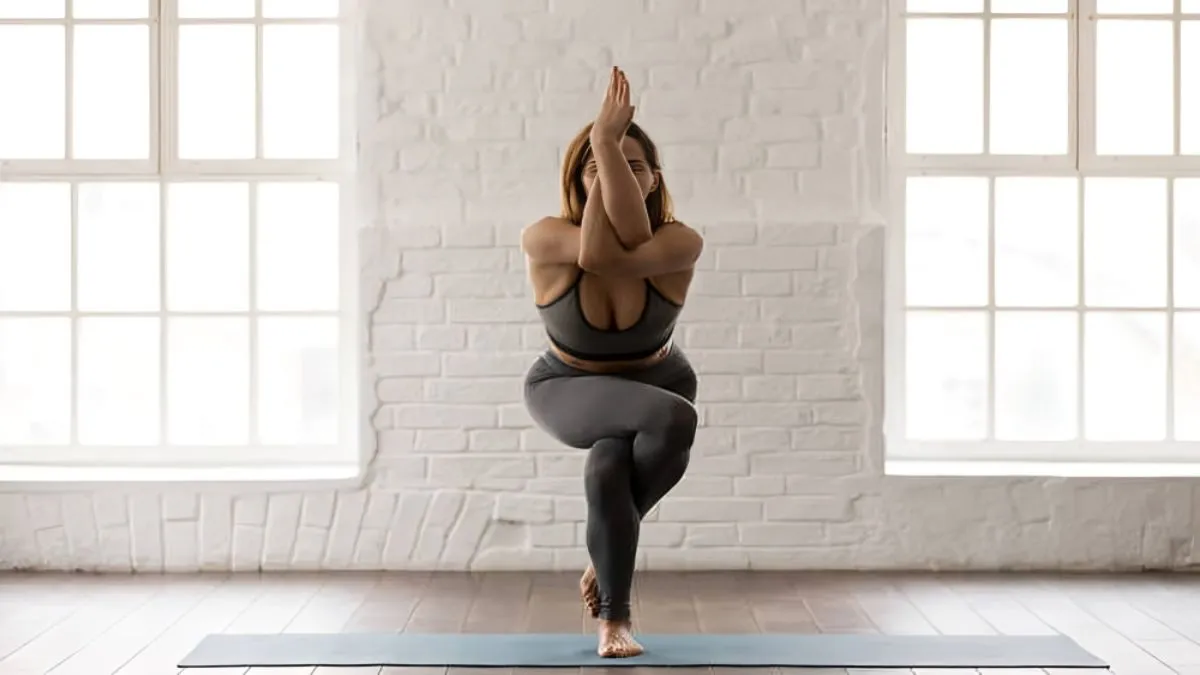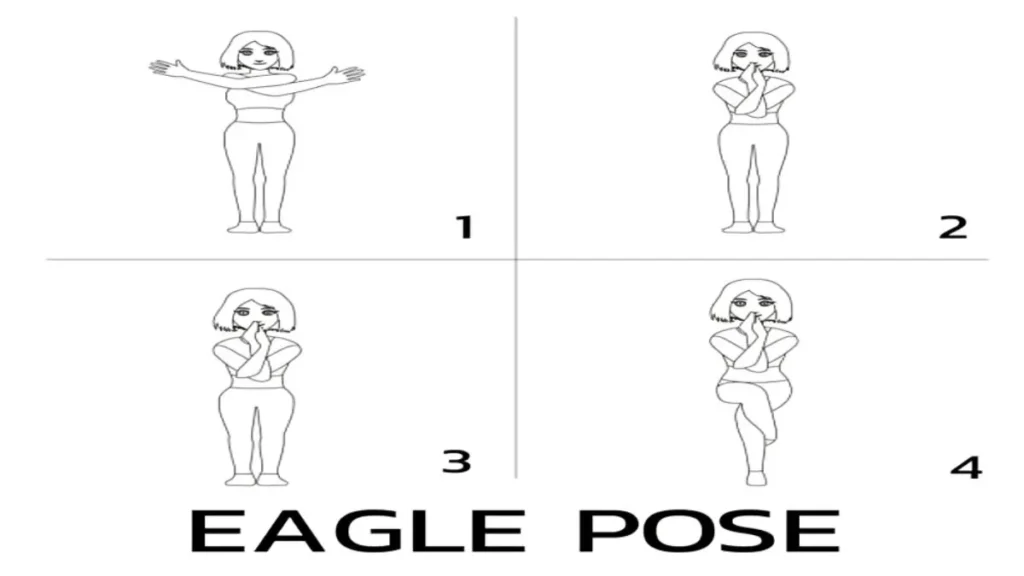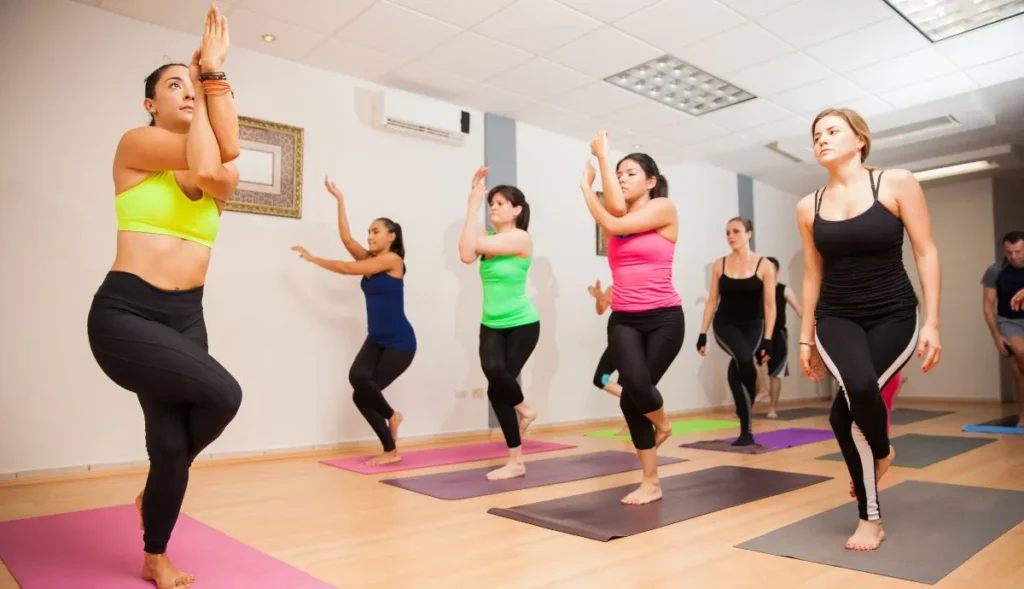YOGA
Eagle Pose: Quick and Easy Guide

Eagle Pose, known as Garudasana in Sanskrit, is a unique standing posture that embodies the essence of focus, strength, and flexibility. This poses challenges to your balance while simultaneously enhancing your mental concentration and coordination. Eagle Pose not only stretches various muscle groups but also fosters a sense of grounding and calmness. Practising this pose can be transformative, promoting emotional resilience and mental clarity. Whether you are a seasoned yogi or a newcomer to the mat, Eagle Pose offers benefits that can elevate your yoga practice and overall well-being.
Anatomy of Eagle Pose
Understanding the anatomy of Eagle Pose can enhance your practice and awareness. This pose primarily engages the legs, core, shoulders, and upper back. The main muscle groups involved include the quadriceps, hamstrings, and glutes, which work to maintain balance and stability. Additionally, the shoulders and upper back stretch and strengthen as the arms intertwine. Being aware of your body mechanics while performing Eagle Pose not only aids in achieving proper alignment but also enhances overall body awareness during your yoga practice. Respecting your body’s limits can help you enjoy a safer and more fulfilling experience.
Preparing for Eagle Pose
Before stepping into Eagle Pose, it’s crucial to warm up your body with preparatory exercises. Poses like Warrior II and Tree Pose help activate the legs and improve balance, while gentle shoulder stretches will prepare your upper body. Incorporating poses like Cobra or Cat-Cow can enhance spinal flexibility, which is essential for the twist in the Eagle Pose. As you warm up, take a moment to connect with your breath, fostering a sense of calm and focus. This preparation sets the stage for a successful practice, making the transition into Eagle Pose smoother and more enjoyable.
Step-by-Step Instructions for Eagle Pose
- Begin in Tadasana (Mountain Pose), standing tall with your feet hip-width apart and arms relaxed by your sides.
- Shift your weight onto your right foot and bend your left knee, lifting your left leg off the ground.
- Cross your left thigh over your right thigh, and if possible, hook your left foot behind your right calf.
- Extend your arms in front of you at shoulder height, then cross your right arm under your left arm, bending your elbows.
- Wrap your forearms around each other, bringing your palms together if possible. If that’s not accessible, keep your hands on your shoulders.
- Bend your knees slightly and lower your hips as you sink into the pose, maintaining a tall spine.
- Focus your gaze on a fixed point in front of you to enhance your balance. Hold the pose for several breaths before slowly unwinding and switching sides.

Common Mistakes in Eagle Pose
As you explore Eagle Pose, it’s common to encounter a few pitfalls. One prevalent mistake is collapsing the chest, which can limit the effectiveness of the stretch in the shoulders and upper back. Ensure that your chest remains open and lifted throughout the pose. Additionally, allowing the knee of the standing leg to buckle inward can destabilize your balance. Make sure your knee aligns with your ankle for better support. Lastly, forgetting to engage your core can compromise stability and strength. Awareness of these common mistakes can guide your practice toward a more rewarding experience.
Tips for Mastering Eagle Pose
Mastering Eagle Pose requires patience and practice. One essential tip is to focus on your breath; deep, steady breaths create a sense of calm and stability, allowing you to stay present in the pose. Visualization techniques can also be helpful; imagine your body as strong and rooted, with your limbs intertwined like the wings of an eagle. Using props, like a chair for support, can provide additional assistance while building confidence. Remember, it’s okay to wobble or lose balance—every attempt teaches you something new. Embrace the process and trust that with persistence, you will find your way into the pose.
Benefits of Eagle Pose
Eagle Pose offers numerous physical and mental benefits that can enhance your overall well-being. Some of the key benefits include:
- Improves balance and coordination: Eagle Pose challenges your sense of balance and coordination, helping to develop overall stability.
- Increases flexibility: This pose provides a deep stretch to the shoulders, hips, and legs, enhancing flexibility in these areas.
- Strengthens muscles: Eagle Pose engages the core, legs, and arms, helping to build strength and endurance.
- Calms the mind: The concentration required in this pose can help reduce stress and promote mental clarity.
- Promotes emotional resilience: Practicing Eagle Pose encourages a sense of grounding, fostering emotional stability and resilience.
- Enhances body awareness: This pose requires a keen awareness of body alignment and movement, promoting greater body consciousness.
Modifications for Beginners
If you’re new to yoga or finding Eagle Pose challenging, modifications can make the journey more accessible. Using a wall for support can help you maintain balance as you work on the pose. Instead of crossing your legs tightly, you can rest your left foot on the floor behind your right calf for added stability. For the arms, if wrapping is difficult, simply place your hands on your shoulders instead. Remember, every yogi’s journey is unique, and modifications are tools to support your practice, not limitations.

How to Overcome Fear in Eagle Pose
Fear can often be a barrier when attempting Eagle Pose, particularly the fear of falling or losing balance. To overcome this, start by practicing near a wall for extra support. Visualization techniques can also be effective; picture yourself achieving the pose with grace and ease. Gradually increasing your time spent in preparatory poses can build your confidence and familiarity. Embrace falling as a natural part of the learning process, viewing it as an opportunity to grow. Sharing your experiences with fellow yogis can also provide encouragement and remind you that you’re not alone on this journey.
Eagle Pose and Injury Prevention
Safety should always be a priority in yoga practice, especially when attempting challenging poses like Eagle. Pay attention to your body’s signals; if you feel pain, it’s essential to stop and reassess. Focus on proper alignment to minimize the risk of injury—ensure that your knees, ankles, and shoulders are aligned correctly. Strengthening your legs and core through preparatory exercises can also help prevent strain. If you’re feeling fatigued or uncertain, don’t hesitate to skip Eagle Pose for the day. Practicing mindfully and listening to your body is vital for a sustainable and injury-free practice.
Conclusion
In conclusion, Eagle Pose is a powerful and transformative practice that embodies the essence of yoga. By embracing the challenges it presents, you cultivate strength, balance, and focus both on and off the mat. Each attempt, whether successful or not, contributes to your growth and understanding of your body. As you incorporate Eagle Pose into your regular practice, remember to celebrate your progress and stay connected to the deeper teachings of yoga. With patience and dedication, you can unlock the potential within you, transforming not just your practice but your entire yoga journey.
-

 GENERAL6 months ago
GENERAL6 months agoChristofle – For Those Who Dream of Family Heirloom Silver
-

 SPORTS8 months ago
SPORTS8 months agoDiscover the World of Football with Streameast: Watch Your Favorite Leagues and Tournaments
-

 GENERAL4 months ago
GENERAL4 months agoUncovering the World of кинокрадко: The Dark Side of Film Piracy
-

 GENERAL2 months ago
GENERAL2 months agoATFBooru: Anime, Gaming, and Subculture Imageboard























